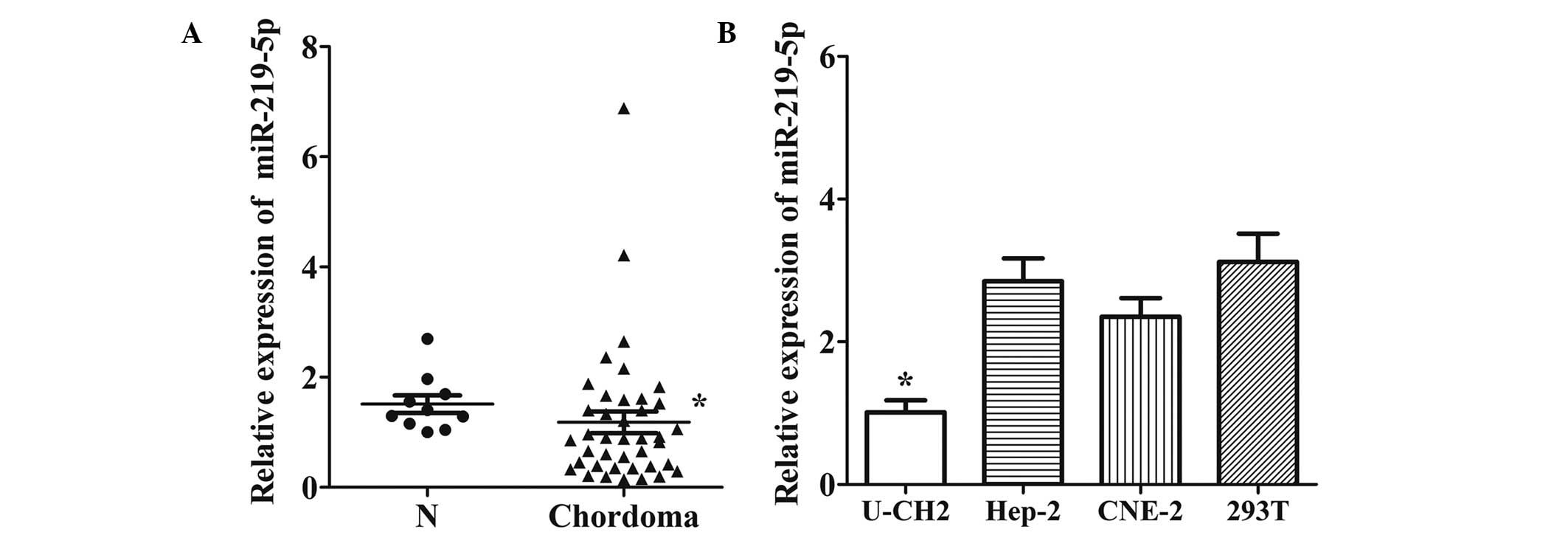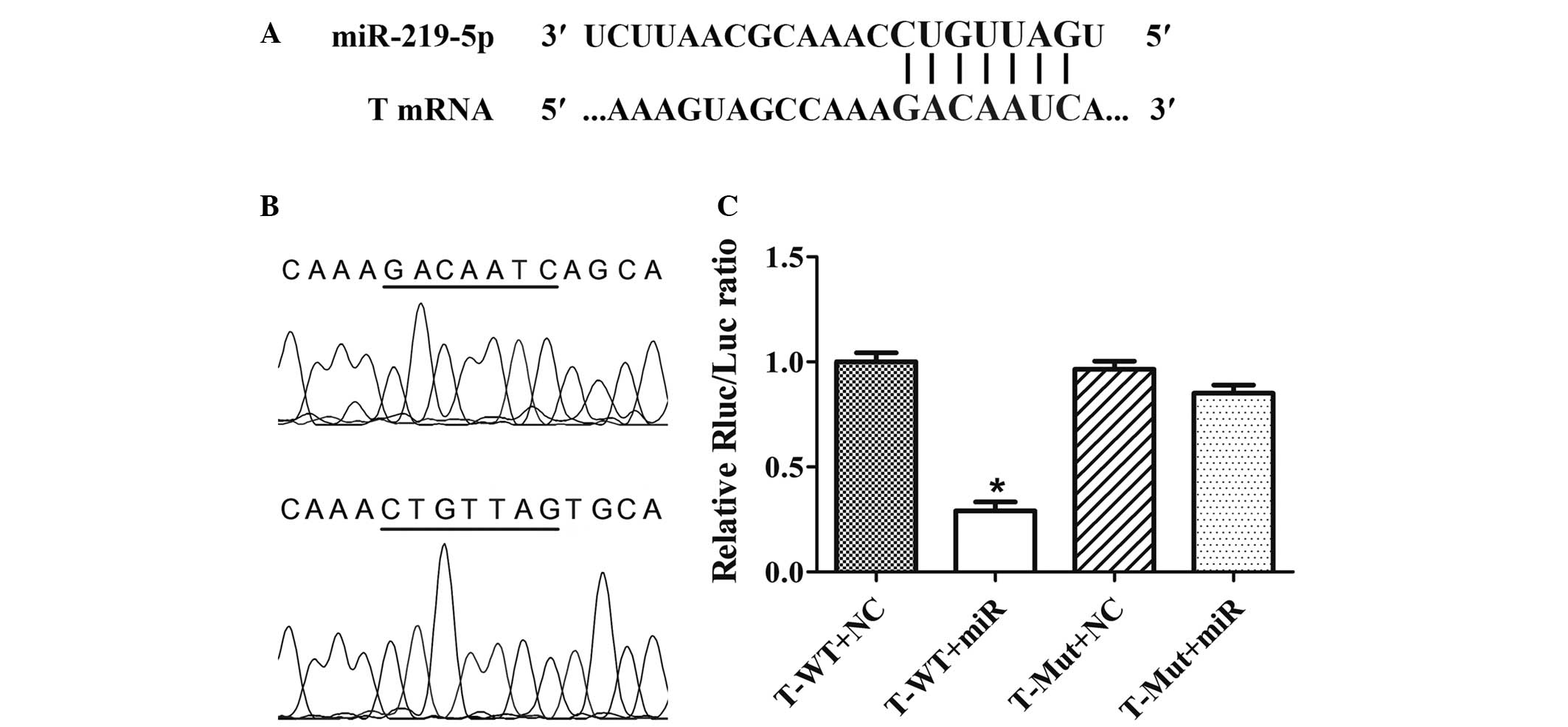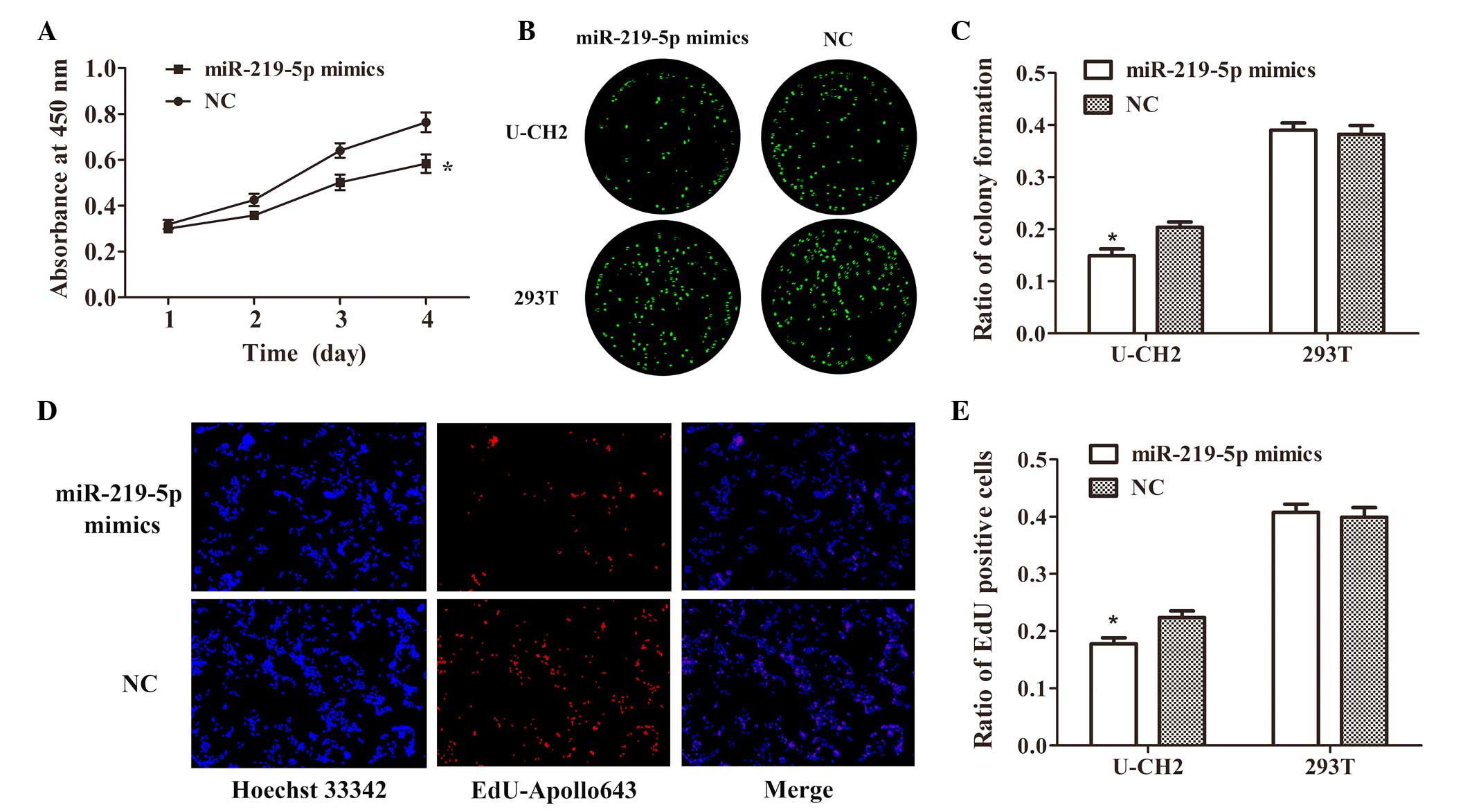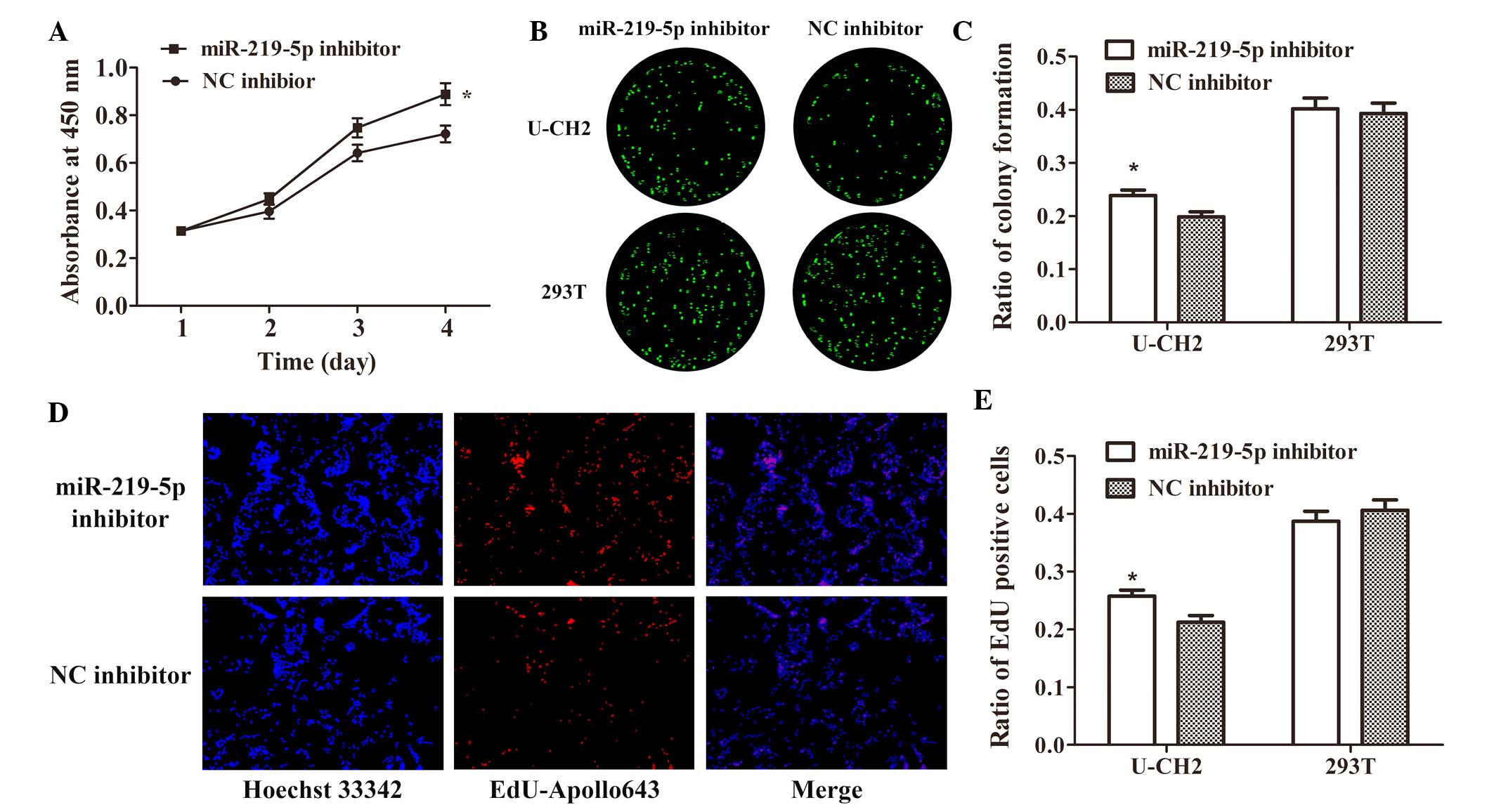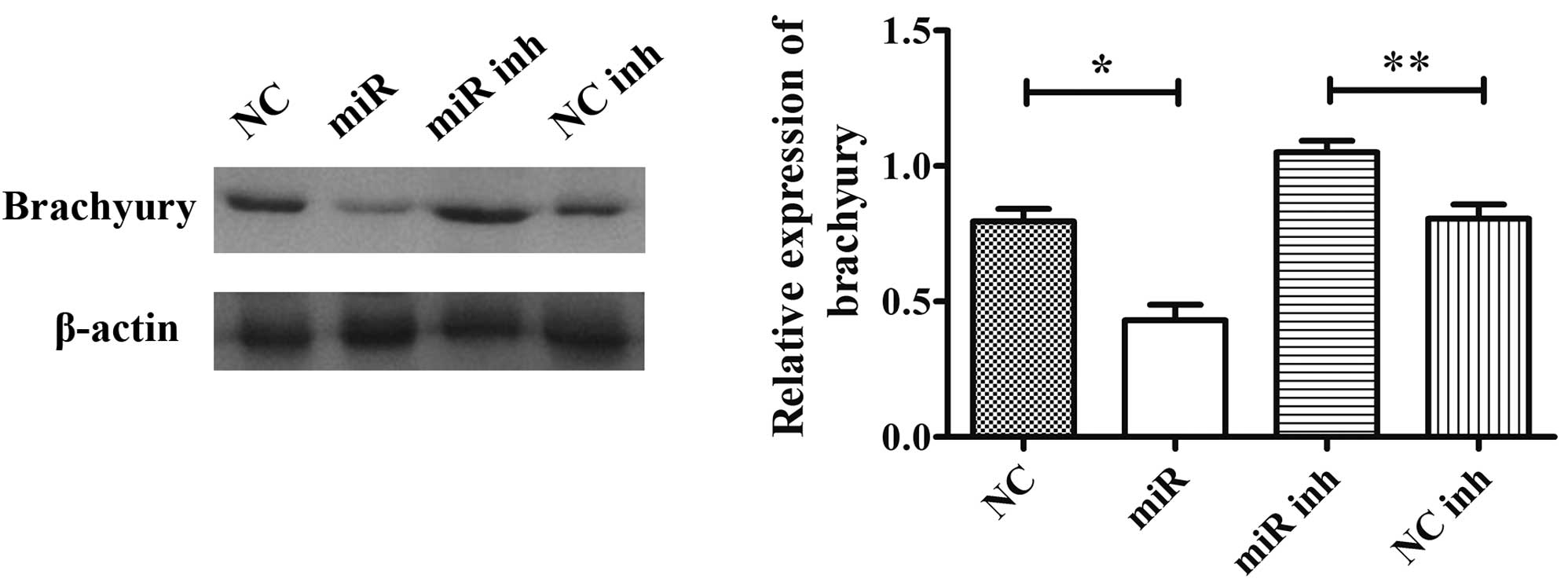|
1
|
Casali PG, Stacchiotti S, Sangalli C, Olmi
P and Gronchi A: Chordoma. Curr Opin Oncol. 19:367–370. 2007.
View Article : Google Scholar : PubMed/NCBI
|
|
2
|
Stippler M, Gardner PA, Snyderman CH,
Carrau RL, Prevedello DM and Kassam AB: Endoscopic endonasal
approach for clival chordomas. Neurosurgery. 64:268–277. 2009.
View Article : Google Scholar : PubMed/NCBI
|
|
3
|
Vujovic S, Henderson S, Presneau N, Odell
E, Jacques TS, Tirabosco R, Boshoff C and Flanagan AM: Brachyury, a
crucial regulator of notochordal development, is a novel biomarker
for chordomas. J Patho. 209:157–165. 2006. View Article : Google Scholar
|
|
4
|
Yang XR, Ng D, Alcorta DA, Liebsch NJ,
Sheridan E, Li S, Goldstein AM, Parry DM and Kelley MJ: T
(brachyury) gene duplication confers major susceptibility to
familial chordoma. Nat Genet. 41:1176–1178. 2009. View Article : Google Scholar : PubMed/NCBI
|
|
5
|
Presneau N, Shalaby A, Ye H, Pillay N,
Halai D, Idowu B, Tirabosco R, Whitwell D, Jacques TS, Kindblom LG,
et al: Role of the transcription factor T (brachyury) in the
pathogenesis of sporadic chordoma: A genetic and functional-based
study. J Pathol. 223:327–335. 2011. View Article : Google Scholar : PubMed/NCBI
|
|
6
|
Hsu W, Mohyeldin A, Shah SR, ap Rhys CM,
Johnson LF, Sedora-Roman NI, Kosztowski TA, Awad OA, McCarthy EF,
Loeb DM, et al: Generation of chordoma cell line JHC7 and the
identification of Brachyury as a novel molecular target. J
Neurosurg. 115:760–769. 2011. View Article : Google Scholar : PubMed/NCBI
|
|
7
|
Szuhai K and Hogendoorn PC: ‘The chicken
or the egg?’ dilemma strikes back for the controlling mechanism in
chordoma(#). J Pathol. 228:261–265. 2012. View Article : Google Scholar : PubMed/NCBI
|
|
8
|
Farazi TA, Spitzer JI, Morozov P and
Tuschl T: MiRNAs in human cancer. J Pathol. 223:102–115. 2011.
View Article : Google Scholar : PubMed/NCBI
|
|
9
|
Weis SM and Cheresh DA: Tumor
angiogenesis: Molecular pathways and therapeutic targets. Nat Med.
17:1359–1370. 2011. View
Article : Google Scholar : PubMed/NCBI
|
|
10
|
Le XF, Merchant O, Bast RC and Calin GA:
The roles of microRNAs in the cancer nvasion-metastasis cascade.
Cancer Microenviron. 3:137–147. 2010. View Article : Google Scholar : PubMed/NCBI
|
|
11
|
Li H, Xie S, Liu M, Chen Z, Liu X, Wang L,
Li D and Zhou Y: The clinical significance of downregulation of
mir-124-3p, mir-146a-5p, mir-155-5p and mir-335-5p in gastric
cancer tumorigenesis. Int J Oncol. 45:197–208. 2014.PubMed/NCBI
|
|
12
|
Xu XM, Qian JC, Deng ZL, Cai Z, Tang T,
Wang P, Zhang KH and Cai JP: Expression of miR-21, miR-31, miR-96
and miR-135b is correlated with the clinical parameters of
colorectal cancer. Oncol Lett. 4:339–345. 2012.PubMed/NCBI
|
|
13
|
Jikuzono T, Kawamoto M, Yoshitake H,
Kikuchi K, Akasu H, Ishikawa H, Hirokawa M, Miyauchi A, Tsuchiya S,
Shimizu K and Takizawa T: The miR-221/222 cluster, miR-10b and
miR-92a are highly upregulated in metastatic minimally invasive
follicular thyroid carcinoma. Int J Oncol. 42:1858–1868.
2013.PubMed/NCBI
|
|
14
|
Ries J, Vairaktaris E, Agaimy A, Kintopp
R, Baran C, Neukam FW and Nkenke E: MiR-186, miR-3651 and miR-494:
Potential biomarkers for oral squamous cell carcinoma extracted
from whole blood. Oncol Rep. 31:1429–1436. 2014.PubMed/NCBI
|
|
15
|
Flanagan AM and Yamaguchi T: ChordomaWHO
Classification of Tumours of Soft Tissue and Bone. IARC Press;
Lyon: pp. 328–329. 2013
|
|
16
|
Livak KJ and Schmittgen TD: Analysis of
relative gene expression data using real-time quantitative PCR and
the 2(−Delta Delta C(T)) Method. Methods. 25:402–408. 2001.
View Article : Google Scholar : PubMed/NCBI
|
|
17
|
Duan Z, Choy E, Nielsen GP, Rosenberg A,
Iafrate J, Yang C, Schwab J, Mankin H, Xavier R and Hornicek FJ:
Differential expression of microRNA (miRNA) in chordoma reveals a
role for miRNA-1 in Met expression. J Orthop Res. 28:746–752.
2010.PubMed/NCBI
|
|
18
|
Osaka E, Yang X, Shen JK, Yang P, Feng Y,
Mankin HJ, Hornicek FJ and Duan Z: MicroRNA-1 (miR-1) inhibits
chordoma cell migration and invasion by targeting slug. J Orthop
Res. 32:1075–1082. 2014. View Article : Google Scholar : PubMed/NCBI
|
|
19
|
Duan Z, Shen J, Yang X, Yang P, Osaka E,
Choy E, Cote G, Harmon D, Zhang Y, Nielsen GP, et al: Prognostic
significance of miRNA-1 (miR-1) expression in patients with
chordoma. J Orthop Res. 32:695–701. 2014. View Article : Google Scholar : PubMed/NCBI
|
|
20
|
Zhang Y, Schiff D, Park D and Abounader R:
MicroRNA-608 and microRNA-34a regulate chordoma malignancy by
targeting EGFR, Bcl-xL and MET. PLoS One. 12:e915462014. View Article : Google Scholar
|
|
21
|
Long C, Jiang L, Wei F, Ma C, Zhou H, Yang
S, Liu X and Liu Z: Integrated miRNA-mRNA analysis revealing the
potential roles of miRNAs in chordomas. PLoS One. 8:e666762013.
View Article : Google Scholar : PubMed/NCBI
|
|
22
|
Nelson AC, Pillay N, Henderson S, Presneau
N, Tirabosco R, Halai D, Berisha F, Flicek P, Stemple DL, Stern CD,
et al: An integrated functional genomics approach identifies the
regulatory network directed by brachyury (T) in chordoma. J Pathol.
228:274–285. 2012. View Article : Google Scholar : PubMed/NCBI
|
|
23
|
Shalaby AA, Presneau N, Idowu BD, Thompson
L, Briggs TR, Tirabosco R, Diss TC and Flanagan AM: Analysis of the
fibroblastic growth factor receptor-RAS/RAF/MEK/ERK-ETS2/brachyury
signalling pathway in chordomas. Mod Pathol. 22:996–1005. 2009.
View Article : Google Scholar : PubMed/NCBI
|
|
24
|
Pillay N, Amary FM, Berisha F, Tirabosco R
and Flanagan AM: P63 does not regulate brachyury expression in
human chordomas and osteosarcomas. Histopathology. 59:1025–1072.
2011. View Article : Google Scholar : PubMed/NCBI
|
|
25
|
Rao SA, Santosh V and Somasundaram K:
Genome-wide expression profiling identifies deregulated miRNAs in
malignant astrocytoma. Mod Pathol. 23:1404–1417. 2010. View Article : Google Scholar : PubMed/NCBI
|
|
26
|
Rao SA, Arimappamagan A, Pandey P, Santosh
V, Hegde AS, Chandramouli BA and Somasundaram K: MiR-219-5p
inhibits receptor tyrosine kinase pathway by targeting EGFR in
glioblastoma. PLoS One. 8:e631642013. View Article : Google Scholar : PubMed/NCBI
|
|
27
|
Zhi F, Zhou G, Wang S, Shi Y, Peng Y, Shao
N, Guan W, Qu H, Zhang Y, Wang Q, et al: A microRNA expression
signature predicts meningioma recurrence. Int J Cancer.
132:128–136. 2013. View Article : Google Scholar : PubMed/NCBI
|
|
28
|
Huang N, Lin J, Ruan J, Su N, Qing R, Liu
F, Lv C, Zheng D and Luo R: MiR-219-5p inhibits hepatocellular
carcinoma cell proliferation by targeting glypican-3. FEBS Lett.
23:884–891. 2012. View Article : Google Scholar
|
|
29
|
Huang C, Cai Z, Huang M, Mao C, Zhang Q,
Lin Y, Zhang X, Tang B, Chen Y, Wang X, et al: MiR-219-5p modulates
cell growth of papillary thyroid carcinoma by targeting estrogen
receptor α. J Clin Endocrinol Metab. 100:E204–E213. 2015.
View Article : Google Scholar : PubMed/NCBI
|
|
30
|
Kitamura Y, Sasaki H, Kimura T, Miwa T,
Takahashi S, Kawase T and Yoshida K: Molecular and clinical risk
factors for recurrence of skull base chordomas: Gain on chromosome
2p, expression of brachyury and lack of irradiation negatively
correlate with patient prognosis. J Neuropathol Exp Neurol.
72:816–823. 2013. View Article : Google Scholar : PubMed/NCBI
|
|
31
|
Zhang L, Guo S, Schwab JH, Nielsen GP,
Choy E, Ye S, Zhang Z, Mankin H, Hornicek FJ, Duan Z, et al: Tissue
microarray immunohistochemical detection of brachyury is not a
prognostic indicator in chordoma. PLoS One. 8:e758512013.
View Article : Google Scholar : PubMed/NCBI
|



